The un(conspicuous) glamour of Coco Chanel
The National Theatre Ballet Brno is one of those daredevils who are not afraid to take risks and regularly includes original projects in its repertoire. Radu Poklitaru got the opportunity last time in autumn in the triple bill Bdění. The second novelty of this theatre season is signed by Mário Radačovský, artistic director of the Brno ballet company.
This former principal dancer has had an impressive dance career, with choreographic experience from his engagements at Nederlands Dans Theater and Les Grands Ballets Canadiens. For two years he coached his own company Ballet Bratislava before joining the National Theatre Brno Ballet in 2013. It is logical that he continued his creative journey, and in addition to abroad, he also performed his works in his current Brno location (e.g. Black and White, Beethoven, Romeo and Juliet, Lady with Camellias). In his latest ballet, he was inspired by Coco Chanel, the French fashion icon whose life steps he followed according to the programme with a clearly stated intention: “I was looking for a key to not drown in the life of Coco Chanel. I deliberately left out a lot of situations and turns in life. The essence of her life, and indeed of every designer's life, in my opinion, is the fashion show.” And it's the mischievous parades of dancers in costumes à la Chanel that form a significant part of the production, capturing in a nutshell the twists and turns of the famous designer's life.
From cabaret to the big world
Gabrielle Chanel (1883-1971) initially sang in cabarets in her spare time and this is where her legendary nickname was born - she liked to sing a song about a girl whose dog named Coco was lost. No one could have guessed that the girl, left with her siblings in an orphanage in Aubazine by her father after her mother's death, would become a woman who embodied French glamour and would change the world of fashion in her lifetime. She was taught to sew by her aunt, whom she used to visit on holidays. That is why, after two years of attendance at the convent school, she was able to enter a men's tailoring shop, where her mesmerising dark eyes, striking profile and handsome, slender and youthful figure captured the heart of retired officer Étienne Balsan, heir to a textile firm and horse breeder. And it was this acquaintance that brought Chanel into the “big world”.
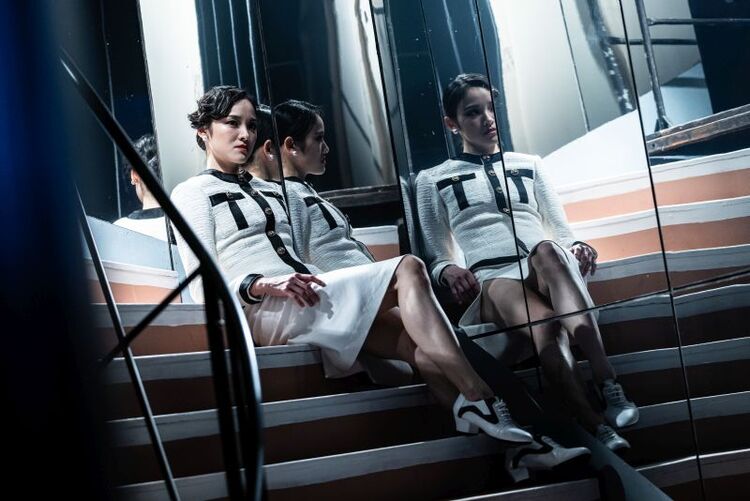
We also enter into it with Coco Chanel at the very beginning of the show, when she comes on stage from the auditorium during the loud clacking of heels, wearing her famous black and white costume consisting of a short jacket and a knee-length skirt. She is at the height of her career, standing in front of a semicircular longitudinally cut mirrored wall, slowly smoking a cigarette. On the other side of the rippling mirror, a look-alike stands, mimicking the soloist's posture. Only when she removes her high-heeled shoes does she softly slide across the floor, swirling through the space and diving into memories. The mirrored panel rides upwards, revealing in shards the events in the life of a legendary woman who was one of the greatest figures of fashion in the first half of the twentieth century.
On one side, the revolving stage offers the environment of a studio where fashion collections are created, and other time seamstresses dance behind sewing machines with scissors and cloths in their hands. On the other side of the turntable there are private interiors where love flares, break-ups, losses and a return to the limelight take place. In one of the final cuts, a darker part of Chanel's life is revealed - her collaboration with the Nazis (although much was known about her possible collaboration with them, it wasn't until 40 years after the fashion icon's death that documents emerged from the archives that convicted the famous designer of wartime collaboration). But as I have already mentioned, Radačovský announced that he did not follow the life of the famous designer consistently, so he did not explore it in more depth or deal with her adventures with artists such as Stravinsky or Picasso. He focused on the phenomenon that made Chanel famous as a luxury brand - fashion.
Shows both elegant and crazy
Simply sophisticated and elegant costumes abound, not only showcased by the dancers/models, but also joined by dancers dressed in women's dresses and heels. The first show is full of pastel colours, already showing Chanel bags, hats and skirts that are still long and flowy. Male models mingle in amongst the females, bare-chested at first, wearing only long, wide trousers, but later they unconcealedly embrace their female identity, blurring the gender line and contorting themselves in gowns as seductively as their colleagues. The rapid movements are set to thunderous echoes and it is a distinctive rhythm that structures this fashion show filled with gestures, poses, slides and leaps. The second parade is in black and white, the Charleston comes into its own in the dancing and the final fashion show offers a range of colour and cut variations. One thing remains constant, however, and that is Chanel elegance, taste and style captured succinctly and with artistic flair in Ľudmila Várossová's designs.
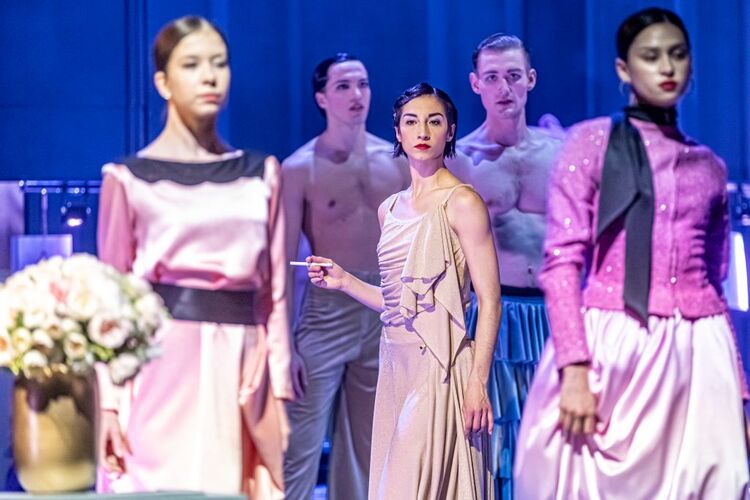
In between the ensemble runway “interludes” are scenes depicting Coco's relationship with Étienne Balsan and the actress Emilienne d'Alençon, who was also his mistress. The trio is played out as a love triangle, with Chanel establishing a relationship with Étienne and seeming suspiciously close to Emilienne as well.
From the sequence of images and the music used, it is clear that Radačovský was inspired by the 2009 biopic Coco avant Chanel by Anne Fontaine, from which the ballet uses not only the musical soundtrack by Alexandre Desplat, perhaps even some of the cuts, but also the landmark of the famous staircase of Chanel's atelier, lined with a mirror, on which the shows of new collections were held during her lifetime - this scenery was also included by Marek Hollý in his stage design in Brno.
Love affairs
Radačovský also focused, besides the corps de ballet scenes/runway shows and the relationship between Balsan and Coco, on her fatal love, the English diplomat and mine owner Arthur Edward Capel, nicknamed Boy. These love affairs are treated with considerably more care than the designer's rapprochement with a high-ranking official, the Gestapo agent Baron Hans Günther von Dincklage, thirteen years her junior.
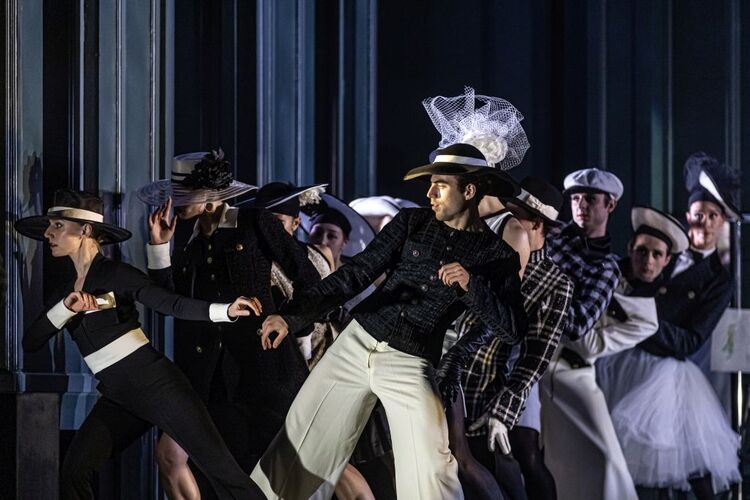
The period that she continued to spend in her suite at the Ritz Hotel during the German occupation is briefly and quite primordially conceived in the ballet, as Chanel sits at a table with her Nazi lover, while men in uniforms salute Heil Hitler on stage. It's a shame that this controversial relationship, which had unfortunate consequences for Chanel, wasn't developed more in the dance form. Instead, the duet between Coco and Arthur, performed by Adrian Sánchez, is beautifully constructed. The pair capture amorous outbursts, devotion, tenderness, enchantment in close physical connection, soaring lifts and in the finale, as the lovers recline on a sofa, other dancers appear on the ground floor and on balconies among the audience. With Arthur, Coco experiences not only love, but also the rise of her professional career, the establishment of her salon among the Parisian elite (its operation was initially financially supported by Arthur Capel and Étienne Balsan), and the sound of the sea surf is a reminder of her time in Deauville and Biarritz, where Chanel opened other shops.
Charm and elegance
However, an independent, determined woman often remains alone. Alone in her studio, cigarette in hand, she creates new models: first her hats, which she originally made for her friend Emilienne, attract attention. In the ballet, we see how she strips off the ruffles, wide skirts and corsets of the women's dresses, how she chooses the scent of the iconic Chanel No. 5. It is done almost civilly, unconsciously: the dancers come from the orchestra pit, the auditorium, the music just flows, completes the atmosphere; it is not necessary to dance it out at all costs, it is enough that the selected melodies reverberate and the performers' believable expressions, captured not only in their faces but in their whole bodies, become more important.
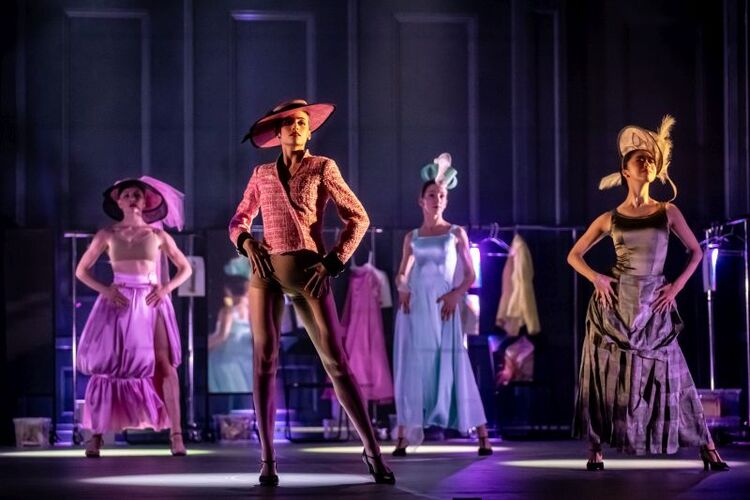
These “resting” moments are crucial for the performer of the title role. If she did not give them expressive finesse and concentration, the precise artistic design would lose an important colour timbre and the subsequent directorial-dramaturgical editing would be meaningless, although even in these situations, a large black and white photographic portrait of Coco Chanel appears in projection as part of the scenographic concept, sensitively completed by the changing lighting on the upper edges of the studio walls or the mirrored wall drawn up from below
Everything stands and falls with the performer of the title role, guest-cast in the premiere by Kristýna Kmentová, a former NdB demi-soloist who hardly leaves the stage. In an expression and dance combining elements of classical and contemporary morphology, she brings out the inner motivations of a woman, fragile, yet strong and tough at the same time. Determined, she pursues what she wants, but also doubts, calculates and experiences a deep loss when her fateful (though married) husband Arthur dies in a car accident and the chansonnier Jacques Brel sings Ne me quitte pas...
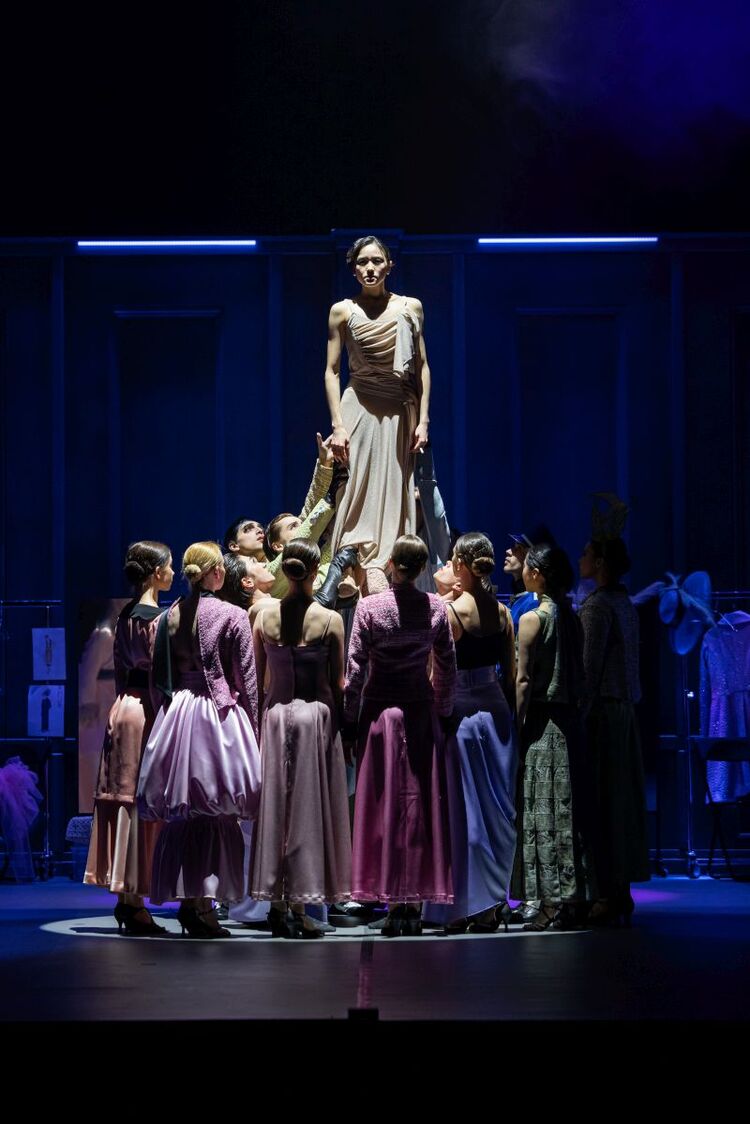
Kristýna Kmentová exudes a special charm and beauty. When she dances, she becomes Coco Chanel. The technical effortlessness is part of her heartfelt expression in the heroine's reminiscences in the individual paintings, which take on a different character and emotional intensity. Radačovský may have provided a sometimes-cramped space for the dancer, but within his artistic vision he has succeeded in creating a consistent production that does not deny the style of the legendary designer and evokes the (in)conspicuous charm of the Chanel fashion brand.
Written from the premiere on 3 May 2024, Mahen Theatre, Brno.
Coco Chanel
Music: Yann Tiersen, Alexandre Desplat, Jacques Brel, Dmitri Shostakovich and others
Choreography, libretto and direction: Mário Radačovský
Scene design: Marek Hollý
Costumes: Ľudmila Várossová
Lights: Roman Jajcik
Musical collaboration: Petr Duchalík
Assistant choreographer: Ivona Jeličová, Thoriso Mago



